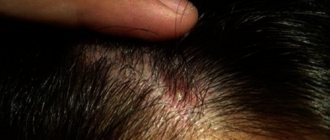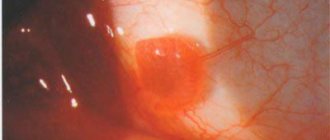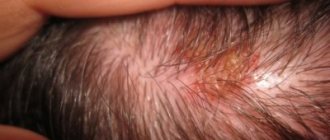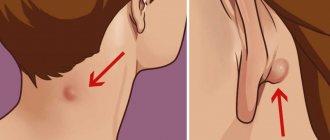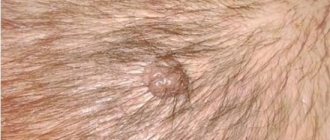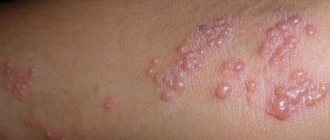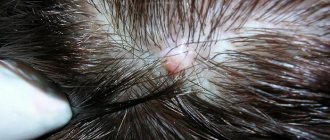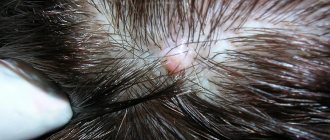As a rule, atheroma occurs in those places where hair is developed. Therefore, the head, rich in sebaceous ducts, often acts as their incubator.
Atheroma on the head is caused by blockage of the sebaceous glands. The reasons are different - for example, as a consequence of injury or against the background of hormonal imbalance.
However, there is another reason. Remember the words of the heroine Ekaterina Vasilyeva from the movie “An Ordinary Miracle”: “What the hell do I need my head for when it hasn’t been washed for three days?” - she asks rightly. Yes, atheroma of the scalp can also occur due to the banal inability to keep hair clean.
Atheroma of the scalp can be congenital. This is a rare case when it can remain unchanged for many years. Or it may be acquired. Such atheroma occurs at any age and can literally grow from the size of a pea to the size of a chicken egg in just a matter of days.
!
In any case, atheroma is a disease that requires the attention of a doctor. And the sooner the better.
Firstly, the signs of atheroma are very similar to the symptoms of another neoplasm - lipoma; often only a professional diagnostician can distinguish them.
Secondly, a bump on the head attracts a lot of unhealthy attention.
In addition, a rapidly growing large atheroma resembles a cerebral hernia (brain prolapse). So, as is the case with any neoplasms, you cannot wait, nothing itself will ever resolve
!
Causes of the phenomenon
The main factor that triggers the process is metabolic disorders, which invariably lead to changes in the functioning of the sebaceous glands, excessive production of sebum and blockage of the excretory tubules. A special risk group is people suffering from excessive sweating, seborrhea or acne.
Experts also point to other reasons for the development of atheroma:
- hormonal imbalance;
- genetic characteristics;
- endocrine diseases (diabetes);
- mechanical injuries to the scalp;
- neglect of hair coloring techniques;
- increased concentration of testosterone in the blood;
- inflammation of the scalp;
- seborrhea, causing damage to the hair follicles;
- abuse of fatty, spicy or salty foods;
- prolonged stress or chronic nervous tension.
Atheroma on the head can form due to improper development of the sebaceous glands, changes in the composition of the sebaceous secretion (its thickness increases) and due to a narrowing of the excretory canaliculi of the glands. In men, such cysts appear more often due to the intense work of the sebaceous glands and neglect of personal hygiene rules.
Prevention
Based on the fact that the development of atheroma occurs due to impaired functioning of the sebaceous glands, in order to prevent such a pathology, you should adhere to some rules:
- Maintain personal hygiene;
- Regularly care for the skin on your head, carefully choosing balms and shampoos;
- Use chemical hair dyes less often;
- Stick to a healthy diet, eliminating too fatty, spicy and salty foods from your diet;
- Treat chronic skin diseases in a timely manner.
With timely treatment and absence of suppuration, atheromas are completely safe. If a small cyst appears on your head, the main thing is not to hesitate and remove it before any complications arise. An experienced doctor will be able to quickly eliminate the cyst without leaving any blemishes on the skin.
New growths on the skin appear less frequently if you:
- maintain personal hygiene;
- use good skin care products;
- monitor the quality of food;
- avoid stress;
- strengthen the immune system;
- undergo medical examinations on time;
- pay attention to disruptions in the functioning of the endocrine and digestive systems.
Have you been diagnosed with atheroma? Find a good specialist to prescribe timely treatment. Atheroma of the scalp is an unpleasant phenomenon. The sooner you start fighting a benign tumor, the higher the chances of recovery.
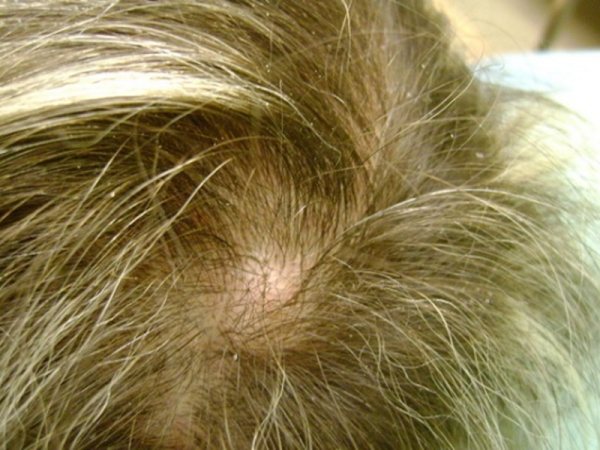
Since the causes of atheroma are not fully established, preventive measures are defined in the most general context. You can prevent blockage of the skin's sebaceous glands by following simple hygiene rules:
- maintaining body cleanliness;
- use of personal protective equipment when working in hazardous industries;
- fight against excess oily skin.
If there is a hereditary predisposition, a person needs to undergo regular medical examinations from specialists.
Blockage of the sebaceous glands is not only a cosmetic defect, but often a signal of serious health problems. If a fatty cyst appears, you should contact a dermatologist or surgeon for examination and determine further treatment tactics. Emergency medical care is especially important for purulent inflammation of this skin defect. Attempts to independently solve the problem are fraught with complications and relapses.
There are no similar articles.
Symptoms
At first, the pathology has no symptoms, and a typical clinical picture emerges only when the atheroma on the head reaches a significant size.
Characteristic signs of an epidermal cyst:
- a compaction is felt in the hair, the size of which can vary;
- the formation has clear boundaries and looks like a ball or lump;
- hair begins to fall out at the site of atheroma;
- to the touch the formation is a soft and pliable tumor;
- the cyst is mobile, but does not move from its location, since it is fused to the skin;
- the surface of the atheroma is smooth, the skin around it is no different from the surrounding one.
The formation on the head can spontaneously open. In this case, foul-smelling contents begin to be released from the hole in the cyst shell - a fatty, thick, yellow-brown secretion, reminiscent of cottage cheese in consistency.
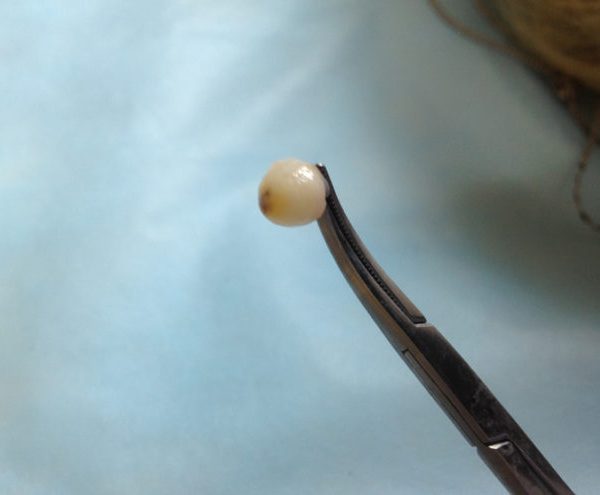
Atheromas are dangerous due to the likelihood of suppuration. In this case, the inflammatory process develops rapidly, with signs of intoxication: pain appears, body temperature rises, and everything can end in a subcutaneous abscess. Swelling appears around the inflamed atheroma, and the skin becomes hyperemic (reddened).
If the “abscess” opens out and the contents of the capsule flow out, the person’s condition noticeably improves.
In severe situations, when a cyst opens under the skin, all the symptoms of an abscess and intoxication appear. The patient
- your health suddenly deteriorates;
- headache;
- pressure drops;
- fever develops and the temperature rises.
Medical assistance must be immediate, otherwise complications are inevitable. Atheromas that have developed on the head should be removed in a timely manner, since a large cyst puts pressure on blood vessels and causes constant pain. But atheroma that occurs in the back of the head may well cause vision impairment.
If such a formation appears on the baby’s head, do not delay contacting a doctor and undergoing surgery: the child may accidentally scratch or otherwise damage the “bump” and cause an infection there. To avoid inflammation and other dangerous complications, you should get rid of atheroma as soon as possible.

How to recognize the disease
- A formation resembling a ball appears on the head. The sizes are different. The cyst is quite soft to the touch. Some tissue swelling is felt.
- The color of the skin usually does not change. With secondary infection, irritation and redness of the scalp is observed.
- In some cases, the neoplasm remains unchanged for a long period.
- Over time, the lump on the head of the atheroma begins to grow. Sometimes the cyst reaches 10–20 cm in diameter.
In many patients, the tumor becomes inflamed. The skin turns red, swells, the temperature rises, and the inflamed area becomes painful.
The “sac” fills with pus and after a while may burst without outside help. The foul-smelling thick liquid resembles clots of fat.
We have an article on how to treat a pimple on the tongue. Only effective methods.
A lot of interesting things have been written here about laser removal of moles on the face.
Treatment methods for atheroma
Before starting treatment, it is necessary to undergo an examination. Atheromas externally resemble lipomas, fibromas, hemangiomas or dermoids, so it is very important to correctly differentiate the pathology. When the diagnosis is made, the doctor chooses the optimal method for removing atheroma on the head.
Unfortunately, a conservative approach to treating atheroma is useless.
Treatment is only surgical. There are several ways to remove atheromas:
- classical surgical method;
- elimination of atheroma with laser;
- removal of the cyst using radio waves.
Surgical method
Such an intervention is impossible without local anesthesia. The surgical method is highly effective because it allows you to remove the atheroma with a capsule, and this reduces the likelihood of relapse. During the operation, the skin over the cyst is cut and moved to the sides. The doctor presses on the formation from the sides, and the cyst seems to “pop” out of the wound. Next, an antiseptic is injected into the cavity and sutures are applied.
During the rehabilitation period, the patient is sometimes prescribed antibiotics, but how long the course will last will depend on the specific case.
The surgical method of combating atheroma is used only for treating adults. In children, an inflamed formation is removed in this way or the procedure is performed for medical reasons.
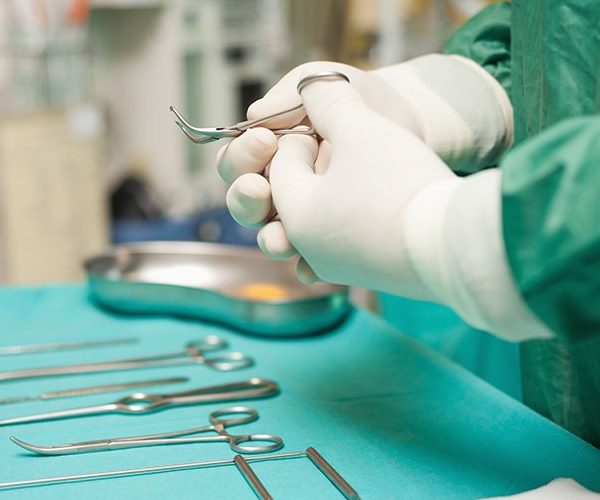
Laser removal
This is the safest method and does not leave postoperative scars. The method is indispensable if you need to get rid of formations on open areas of the body: face, neck, hands. But the laser is effective only for small formations (up to 5 mm). When the atheroma reaches a significant size, the laser method is combined with surgery.
Radio wave method
With this method of removing atheroma, the chances of relapse are also minimized, since the cyst is removed with the capsule. This method does not require stitches, that is, there will be no cosmetic defects, and there is no need to remove hair at the site of the tumor. Another advantage of the method is the short recovery period, and with it the minimal risk of complications.
After eliminating the atheroma by any of the methods, its contents are sent for histological examination.
The analysis allows us to exclude a malignant process. Do not forget that independent attempts to get rid of the formation (squeezing) can result in infection and the development of an inflammatory process.
Traditional medicine methods
When you detect the first signs of atheroma, you should immediately seek medical help, because traditional medicine can help relieve inflammation and get rid of pain, but not remove the root of the disease.
Anti-inflammatory drugs for oral administration
- A few coltsfoot leaves are poured into a glass of boiling water and simmered over low heat for 5-10 minutes. The resulting decoction is drunk half a glass once a day;
- Daily consumption of wheat germ juice will help improve the general condition of the body and relieve inflammation;
- 3 burdock roots must be crushed and poured with 150 milliliters of vodka. The resulting mixture is bottled, hermetically sealed and infused in a dark place for a month, while the container is constantly shaken. The prepared tincture is consumed twice a day, half an hour before meals.
Traditional medicine for external use
- lamb fat needs to be melted a little and rubbed into the resulting wen 5 times a day;
- atheroma can also be lubricated with freshly prepared aloe juice, the procedure is repeated 5-6 times a day;
- 2 tablespoons of crushed peony roots are poured into 500 ml of hot water and boiled for 2-3 minutes. Cool the broth and wipe the sore spot with it;
- 3 tablespoons of finely chopped wormwood are poured into 500 ml of boiling water and left for 30 minutes. The tincture is then filtered and used as a compress;
- Pour 1 tablespoon of primrose herb into a glass of boiling water and cook for about 5 minutes. Then the broth is cooled and filtered. Used as a bath additive.
Details about herpes zoster: symptoms and treatment in adults.
Read all about the causes and treatment of myositis in this article.
Traditional medicine methods suitable for certain areas of localization:
- in order to get rid of atheroma on the head, it is necessary to wipe the neoplasm daily with a decoction of anti-inflammatory herbs such as chamomile, St. John's wort and calendula;
- A mixture of laundry soap and onions is also good for this area. To prepare it, 1 chopped, baked onion is mixed with a tablespoon of grated soap. Lubricate the wen with the prepared product 3 times a day;
- Egg film is well suited for the face, which must be carefully separated from the raw egg. It is applied to the atheroma and held until completely dry;
- For the earlobe, a compress prepared using a bandage, which is moistened in a mixture of 2 tablespoons of ammonia and 2 tablespoons of water, is well suited. The duration of the procedure is 5-7 minutes; after removing the lotion, the wen should be thoroughly rinsed with water.
Treatment of atheroma with ichthyol ointment
To relieve inflammation in atheroma, you can use ichthyol ointment or Vishnevsky ointment. These two products are similar to each other in the method of influence and rules of application. The main difference lies in the composition of the drugs.
Before use, squeeze a little ointment onto a gauze pad or cotton pad.
This product is secured to the affected area using an adhesive plaster.
While waiting for the operation, she saved herself with decoctions of chamomile and calendula, rubbed the sore spot, and the inflammation noticeably decreased.
I want to tell my story. I began to notice that a bump had formed on my face, at first I thought it was a pimple and waited until it was ripe to squeeze it out, but after I saw that this bump was only growing in size, I ran to the doctor. They said atheroma. At first I panicked, thinking that there would now be a scar on my face, but then I came across a laser removal method. Yes, I had to pay a lot of money, but the result is worth it, it’s as if the wen never happened.
Have you noticed a bump on your head?
You urgently need to see a doctor! What could it be? Perhaps this is atheroma or, as people call it, a wen.
According to experts, a bump on the head is formed due to the fact that the sebaceous glands are clogged. Liquid accumulates in the resulting lump. with an unpleasant odor of yellow color and cheesy consistency. It contains epithelial cells, sebaceous secretions, dead keratinized cells, and cholesterol.
The skin on the wen is no different from normal skin. The atheroma itself is slightly mobile. The person does not experience pain when pressing on the wen. However, if you accidentally damage it, for example, while scratching your head, you can get an infection.
And this can lead to unpleasant consequences, for example, to sepsis of the subcutaneous layer of the head. And this, in turn, leads to a deterioration in a person’s condition, the appearance of fever, headache, increased temperature and a drop in blood pressure.
Doctors note that atheroma, barely noticeable at first, can grow to the size of a chicken egg.
This happens because its contents cannot leave the capsule, gradually accumulating. But it can take a long time to grow. There are cases of congenital atheroma, when it does not change in size throughout life.
Either one or several atheromas can form on the head.
There is no need to wait until the lump grows to an impressive size. After all, even though it is a benign formation, it can give complications and fester at any moment. For example, such a bump on the back of the head can reduce vision.
At the first signs of atheroma, you should consult a doctor. It is he who will make the diagnosis and determine whether it is definitely a wen. The fact is that atheroma is similar in appearance to lipoma, fibroma, and dermoid. Treatment will be different in each case.
Attention. The fatty tissue should not be squeezed out. This can lead to blood poisoning.
Atheroma of the scalp: how to treat it at home and remove it
Atheroma of the scalp is a wen or cyst.
Excessive accumulations of fatty tissue can form on all parts of the body. But most often, such neoplasms appear on the head in the place of hair growth. We will tell you why atheroma occurs, how to recognize it, get rid of it, and when it requires mandatory treatment. Atheroma is a subcutaneous capsule that contains a curdled mass or liquid. Often in the center of such a formation there is a small hole through which these secretions come out. Most often they have a very unpleasant odor.
As you know, in the area of hair growth on the head, every person has an impressive number of sebaceous glands. It is the disruption of their functioning that provokes the appearance of such a cyst-type tumor. In turn, the following factors can lead to improper functioning of the sebaceous glands:
- metabolic disease;
- diabetes mellitus and other endocrine diseases;
- significant increase in sweating;
- insufficient hygiene;
- regular hair dyeing with chemicals, as well as frequent curling;
- heredity;
- nervous tension and fatigue;
- Infants have imperfect thermoregulation.
How to recognize atheroma?
It is not at all difficult to notice atheroma on the scalp. As a rule, a person, while combing, discovers a round lump on his head. The size of this formation can range from 5 mm to 10 cm.
Upon detailed examination, you can notice a ball moving under the skin, and at the place where it appears, the scalp becomes smooth and shiny. When you press on this new formation, you can hear a squelching sound and also feel the ball move a few millimeters in different directions. This does not cause pain or discomfort. In addition, hair often falls out at the site of the cyst formation.
Often people who have discovered signs of this disease do not seek medical help, since this formation is small in size and does not bother them at all. Meanwhile, in case of inflammation of atheroma, you should consult a doctor immediately. You can understand that the cyst is inflamed by the following signs:
- swelling and redness of the skin in the area of compaction;
- increase in tumor size;
- pain or discomfort when pressing;
- the appearance of a secretion that has an unpleasant odor;
- general malaise and fever.
If such symptoms appear, you should consult a doctor as soon as possible. A qualified doctor will conduct an examination and differential diagnosis.
Before starting treatment, it is necessary to establish a diagnosis with high accuracy, since atheroma of the scalp can have clinical manifestations similar to the symptoms of diseases such as hemangioma, lipoma, dermoid cyst, lymphadenitis, and hernia of the meninges.
In some cases, an ultrasound scan of the cyst or computed tomography may be required to confirm the diagnosis. If the doctor has doubts about the benignity of the tumor, he will have to undergo a histological examination to exclude basilar or squamous cell carcinoma.
Is it necessary to remove atheroma and how to do it?
As soon as you discover a sebaceous gland cyst on your head, it is better to remove it immediately. At the moment, removing atheroma is the only way to get rid of it forever.
Of course, atheroma is a benign neoplasm and does not pose such a danger as cancer. However, it can become infected at any time, which can lead to an abscess. During the period of acute inflammation, surgical intervention becomes vital, but it is not possible to remove the atheroma at this moment.
In such a situation, in an operating room under local anesthesia, the cyst is opened, pus is removed from it, thoroughly washed and drained. Next, the patient is prescribed antibiotic therapy. 3 months after drainage, the atheroma must be removed, otherwise a relapse will occur quite quickly.
Removal of atheroma is carried out using two methods:
- if the size of the cyst does not exceed 7 mm, the radio wave method is most often used. In this case, under anesthesia, the capsule is opened and its fatty contents are completely removed. After such an intervention, no special care is required;
- Larger tumors can only be removed surgically. The patient makes a thin incision at the top of the tumor. Then it is freed from the surrounding tissue, after which the contents are removed and stitches are applied, which will need to be removed 5-12 days after the operation. Within 24 hours after surgery, you will need to bandage the incision site several times with sterile gauze.
Treatment of atheroma at home
At the earliest stages of atheroma, traditional methods of treatment can be very effective, for example:
- Cool the melted lamb fat to 20-22 degrees and rub into the affected area of the scalp as often as possible;
- chop the garlic and add a little sunflower oil to it. Mix until you get a paste. This mixture must be rubbed into the wen, while massaging them with your fingers;
- Apply a fresh leaf of coltsfoot to the shiny surface of the atheroma and secure it with an adhesive plaster. After 24 hours, renew the lotion. Repeat treatment for 8-10 days.
Source: https://LadySpecial.ru/zdorovie/narodnaya-mediczina/bolezni-i-lechenie/ateroma-volosistoj-chasti-golovy-kak-lechat-v-domashnikh-usloviyakh-i-udalyayut
Causes of atheroma on the head
Atheroma is a subcutaneous capsule that contains a curdled mass or liquid. Often in the center of such a formation there is a small hole through which these secretions come out. Most often they have a very unpleasant odor.
As you know, in the area of hair growth on the head, every person has an impressive number of sebaceous glands. It is the disruption of their functioning that provokes the appearance of such a cyst-type tumor.
In turn, the following factors can lead to improper functioning of the sebaceous glands:
- metabolic disease;
- diabetes mellitus and other endocrine diseases;
- significant increase in sweating;
- insufficient hygiene;
- regular hair dyeing with chemicals, as well as frequent curling;
- heredity;
- nervous tension and fatigue;
- Infants have imperfect thermoregulation.
Why does a wen form on the head?
Risk group for atheroma
Doctors note that a similar disease occurs in women, men and even children. Men, by the way, suffer from the appearance of atheroma more often. They tend to eat fattier foods and often neglect hygiene procedures.
Practice has shown that atheroma is formed due to blockage of the sebaceous glands, disruption of the hair follicles, rupture of the sebaceous gland, high testosterone levels, carbunculosis or furunculosis.
People who sweat frequently
Those who suffer from acne and seborrhea are at risk. In addition, the appearance of a bump on the head is influenced by genetic predisposition and various endocrine diseases, for example, diabetes. In addition, those who have hormonal disorders need to be very careful.
Visitors to beauty salons
Those who often dye their hair, perm their hair, or constantly blow-dry their hair are also at risk of developing a bump on their head. Nervous stress and chronic stress can also lead to the formation of a wen.
Fat lovers
Atheroma forms in those who consume a lot of fatty, spicy and salty foods. Abnormal development of the sebaceous glands, in which the composition of the sebaceous secretion thickens and the ducts themselves narrow, can also lead to the appearance of a lump.
Wen can also occur in children
Doctors say that such cases occur in every second baby. Such bumps develop from epidermal cells and are not considered pathological.
The active work of the sebaceous glands leads to the growth of the lump. As a rule, in children, atheroma looks like a pinpoint rash of white color with a pearlescent tint. The skin around the nodules can become inflamed and sometimes fester.
A baby with such symptoms should definitely be seen by a doctor. He will determine further treatment. As a rule, if there is no inflammatory process, then atheroma in children is not treated. It goes away on its own over time. But during the inflammatory process, rashes are treated with antiseptics.
Etiology
The causes of atheroma are not fully understood. It is believed that the cyst forms in people with a hereditary predisposition, especially during periods of hormonal changes. The immediate cause is blockage of the sebaceous glands with thickened fatty secretions, dust particles, and skin flakes. Against the background of a closed duct, the gland continues to produce sebum, secretion accumulates, and a new growth gradually forms.
The causes of blockage of the sebaceous glands on the face can be various skin diseases. These include acne, furunculosis, seborrhea. If left untreated, they become responsible for the appearance of cysts. This type of atheroma is called secondary.
The provoking factors that lead to clogging of the fat glands are the following circumstances:
- dirty skin;
- constant microtrauma of certain areas of the body;
- chronic dermatological diseases;
- increased sweating;
- hormonal imbalance;
- disorders of fat and carbohydrate metabolism;
- incorrect use of cosmetics;
- cystic fibrosis;
- older age, more often female.
Sometimes atheroma is called epidermoid, or epidermal, cyst, considering these to be synonyms. But that's not true. Congenital epidermoid cysts of the skin are usually multiple in nature and are most often found on the head, torso, arms, and groin. An epidermoid cyst, like the formation of a sebaceous gland, has a capsule consisting of epithelial cells, but its contents are not sebaceous secretions, but scales of the stratum corneum.
In case of microtrauma or infection through the blood, abscesses may form and the infection may spread to surrounding tissues. Localization in the eyelid area is dangerous, as the inflammatory process quickly spreads to the eyeball.
Is it possible to treat a bump on the head on your own?
Indications for removal
Doctors definitely say no. Even if the wen does not hurt or itch, it is necessary to get rid of it as soon as possible. Moreover, surgically.
At any moment, any careless movement can damage the skin and cause infection. Then it will be more difficult to cope with the consequences.
Diagnostics
A patient who seeks help is usually first examined and then sent for Doppler or skull x-ray. He may also be prescribed an ultrasound or CT scan.
Is it possible to use folk remedies?
Experiments in this case will not lead to anything good. By resorting to grandma's recipes, a person can not only waste precious time, but also aggravate the situation.
For example, some people apply lamb fat to the lump. This is not worth doing. After all, atheroma itself is formed due to blockage of the sebaceous glands. Adding foreign fat can only cause harm.
Recipes with garlic, which is also recommended for use in the treatment of atheroma, can cause unnecessary irritation on the skin. Herbs, for example, such as coltsfoot, may soothe the skin. But there is no talk of getting rid of the lump.
The most important thing is that you don’t have to try to squeeze out the lump yourself.
Some use Vishnevsky ointment. It can be applied to the site of formation of the wen for several hours and evaluate the result. If there are no changes, you need to consult a doctor: a dermatologist or surgeon.
Important! There is no need to use traditional medicine recipes in the fight against atheroma. In this case, only a surgeon can help.
Treatment with ointments
There are posts on the Internet, the authors of which claim that they coped with the cyst without surgery. To cure, they used Vishnevsky ointment.
Is this true or a myth? Let's figure it out.
The well-known Vishnevsky ointment really has an anti-inflammatory, regenerating effect. The composition with an unpleasant odor is good at opening boils and other formations filled with pus.
In the case of a cyst, caution is needed. The ointment can be used only in the initial stage
Place a piece of gauze soaked in ointment on the bump, attach it, and leave it for several hours.
Be sure to change the dressings and do not try to squeeze out the contents of the capsule. If after two to three days the lump has not resolved, go to a dermatologist.
This method sometimes gives positive results. But, under the influence of provoking factors, blockage of the sebaceous glands may occur, and the process will begin again.
Important! Do not apply bandages with Vishnevsky ointment to an inflamed, festering cyst. When the abscess is opened, fluid containing bacteria will leak out, infect the wound, and the cyst will develop again.
Is it possible to prevent the appearance of atheroma?
Experts say yes. To do this, you must observe the rules of personal hygiene, do not forget to take a shower, and wash your hair more often.
It is necessary to select the right shampoos and balms in accordance with the type of skin on the head.
It is better to use cosmetics with herbs. If your scalp is oily, you need to use a shampoo that reduces the production of sebaceous secretions.
Doctors also strongly advise not to overuse hair dyeing and perming, and not to use a hot air dryer. And if you use this type of styling, then not often.
You should not delay the treatment of chronic diseases, try to live without stress and stop smoking and drinking alcohol.
Even an incorrectly chosen headdress can contribute to the formation of atheroma. In winter you should wear a warm hat, and in summer you should wear a light hat or Panama hat. By the way, people who already have a bump on their head should definitely wear a Panama hat in hot weather. The fact is that the sun's rays can contribute to the growth or even disruption of the integrity of atheroma.
The diet also needs to be reviewed. To prevent the formation of atheroma, it is necessary to reduce fatty foods, spicy and salty foods from the menu. Animal fats can be consumed, but in small quantities.
It is better to drink milk and eat fruits. This will allow the body to receive the necessary vitamins and boost immunity.
Healthy! Fatty and spicy foods, as well as frequent styling and coloring of hair contribute to the appearance of atheroma.
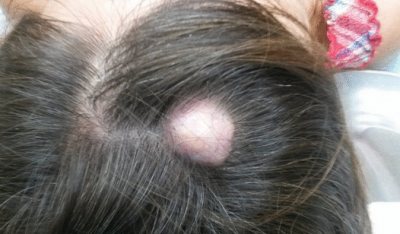
They are formed as a result of blockage of the excretory ducts of the sebaceous gland. The favorite place to appear is the scalp, neck and temporal lobes. This is where the sebaceous glands are most densely located.
It is a dense substance of subcutaneous fat, epidermis and cholesterol. The main difference between atheroma and fibroadenoma and lipoma is that in its center you can see a blocked duct.
Diagnostics
Before starting treatment for atheroma of the scalp, you should undergo a full examination to make an accurate diagnosis. First, the doctor conducts a visual examination and palpates the tumor. Externally, the cyst has similarities with other skin pathologies, so it is necessary to differentiate atheroma from fibroma or lipoma.
To make an accurate diagnosis, the patient may be prescribed the following tests:
- X-ray of the skull;
- ultrasound examination (ultrasound);
- computed tomography (CT).
To make an accurate diagnosis, doctors need to obtain data from additional examination methods. Blood tests are not informative.
The neoplasm is dangerous due to the possibility of malignant degeneration. Therefore, histology of the atheroma biomaterial must be carried out. Confirmation of atheroma on ultrasound is the detection of a cavity in the area of the projection of the sebaceous gland.
In many cases, atheroma is similar in appearance to a lipoma, a benign fatty tumor. In difficult cases, puncture of the contents is performed.
During puncture, the surgeon can immediately remove the cyst and send the sample for histology. An accurate diagnosis is established during the examination of particles of a tumor-like formation.
Important! Don't make a diagnosis yourself: you can easily make a mistake. Incorrect treatment methods will intensify the inflammatory process and lead to the appearance of an abscess.
Causes
Various factors can contribute to its occurrence. The most common of them:
- The formation of atheroma in the scalp is due to the presence of a large number of hair follicles associated with the sebaceous glands. As a result of blockage of the sebaceous duct, the hair root enters the resulting space and a capsule of epithelium is formed around it, which is then filled with subcutaneous sebum and grows in size.
- Hereditary factor. If parents have atheromas , we can say for sure that the child will have the same neoplasms .
- Often the formation is provoked by injuries and damage to the scalp.
- Insufficient skin hygiene. Due to untimely cleansing, the pores become clogged with pieces of epithelium and dirt, which leads to disruption of the outflow of secretions.
- Inflammation of the sebaceous glands and hair follicles. Leads to a deterioration in the outflow of subcutaneous sebum; sometimes, as a result of these processes, epidermal cells enter the duct and do not die, but begin to grow.
- Changes in the body's hormonal levels. So, with hyperthyroidism, the sebaceous glands are activated, the viscosity of the secreted secretion increases, which does not have time to come out in time, then thickens and develops into atheroma. Sometimes such processes can occur in the body of a pregnant woman and child during adolescence.
- The use of products that narrow the sebaceous ducts (deodorants). When the sebaceous excretory tract narrows, the removal of sweat and secretions is disrupted.
- Damage to the sebaceous gland duct during squeezing out acne. Leads to disruption of the excretory channel.
Causes of the disease and characteristic symptoms
Atheroma on the head of a child and an adult does not appear immediately. Initially, itching occurs, and the place where the duct is blocked turns red. The inflammatory process then gradually subsides. At the same time, a tumor begins to grow inside the epidermis. After 2-4 weeks, a bulge forms on the surface of the skin. If the cyst is small, it does not manifest itself in any way.
Under such circumstances, atheroma of the scalp causes the following symptoms:
- pain and swelling on palpation;
- hyperemia of the skin around the formation;
- release of the contents of the cyst, resulting in a sharp putrid odor;
- the volume of atheroma increases sharply over 1-2 days;
- the temperature rises.
If such signs occur, you should immediately consult a doctor.
The development of atheroma occurs without visible symptoms. The cyst becomes noticeable only when it reaches a large size. It resembles a bump on the head, which has smooth contours and does not change the color of the skin. Upon palpation (feeling), the neoplasm does not change location, although it remains mobile. Sometimes the areas of skin where the tumor has formed may become bald. A cyst on the head can open on its own. The contents that come out have a dirty yellow color and an unpleasant odor.
An accurate diagnosis is established after laboratory analysis of the contents of the tumor.
To clarify the diagnosis, the doctor prescribes a histological examination of the contents of the cyst.
The lump that forms on the head does not cause any clinical symptoms for a long time. As atheroma of the scalp develops, the following manifestations occur:
- an elastic round formation appears on the head;
- the surface of the atheroma is smooth, the skin color is healthy;
- the cyst is mobile, but when palpated it does not move because it is connected to the skin;
- the appearance of the pathology is similar to a lump with clear contours;
- in advanced cases, the cyst can open on its own, after which fatty contents with a characteristic odor begin to leak out of it.
Atheromas developing on the head have a tendency to suppurate. Inflammation is usually accompanied by pain, increased body temperature and general malaise. When the cyst opens outward, the patient’s well-being immediately improves, but it can also open inward. In this case, the contents will come out under the skin, which will lead to the development of an abscess and further infection of the entire body. If nothing is done in this condition, the consequences for the patient will be disastrous.
Treatment of education
Since atheroma is a cyst consisting of a dense shell of the epithelium, inside of which there is a pasty substance made from a mixture of sebaceous secretions and particles of keratinized epithelium, attempts to resolve it with folk remedies or squeeze it out without surgical intervention will not be successful. Opening at home is unsafe and can lead to inflammation and suppuration of the tissue area where the atheroma was located. a doctor should deal with this problem in a hospital or operating room.
Before the operation, the specialist must finally make sure that he is dealing with atheroma and not lipoma or fibroma. To do this, it is carefully examined and palpated. In some cases, it is advisable to do a biopsy of its contents; in especially severe cases, when there is suspicion of heterogeneity, an ultrasound is performed. Only after all these measures can you begin removal.
Removal methods
There are several ways to remove scalp atheroma:
- surgically;
- using a laser;
- radio wave method.
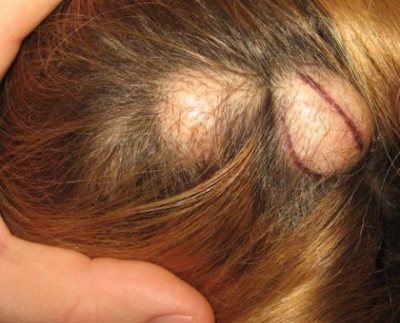
Then, under local anesthesia, an incision is made in the upper part of the atheroma , the contents along with the capsule are removed.
The place where she was located is thoroughly cleaned. Drainage tubes are then inserted into the wound and several stitches are placed. Then the drainage is removed, the wound heals completely. But this method is considered unreliable, since there is a risk of re-formation of atheroma due to poor cleaning of the place where it was originally located.
Small tumors no larger than 2 cm in diameter are removed with a laser, regardless of whether there is suppuration or not. To do this, under local anesthesia, the neoplasm is opened with a scalpel, the contents are removed, but the membrane is not touched. The wound is expanded and the membrane is evaporated using a laser, then drainage tubes are inserted into the resulting void to remove excess fluid. A bandage is applied for 1-2 weeks, then the tube is removed and after some time the wound heals, leaving behind a small scar.
The radio wave removal method removes only small cysts. During this procedure, using special equipment, the tissue surrounding the atheroma is killed in a targeted manner. As a result, it disappears, and a small crust forms in its place.
Currently, it is reasonable to choose the latter method of removal, since it is painless, quick (the operation lasts no more than 30 minutes), does not require hair removal, and there are no scars. Disadvantage: does not allow removing large atheromas.
Advantages and disadvantages of modern methods of radical treatment
The only treatment for trichodermal cysts is surgery. But the method of removing atheroma is chosen by the attending physician. Possible options range from conventional excision of the tumor with a scalpel or biopsy instruments to evaporation of the atheroma with a laser.
The most effective method is laser removal, which has the following advantages over excision with a scalpel:
- The duration of the laser atheroma removal procedure is no more than 20 minutes.
- The operation is bloodless, all vessels are cauterized during coagulation of the neoplasm tissue.
- The laser acts precisely and the healthy tissue surrounding the cyst is not affected.
- There is practically no scar left after laser treatment, and the risk of wound infection is reduced to zero.
- The operation is painless and is performed under local anesthesia.
- There is no postoperative period. The patient goes home immediately after the procedure.
- Thanks to the high precision of laser equipment, all tissue affected by the trichodermal cyst is removed. Relapses after such intervention do not occur or do occur, but extremely rarely.
This method has much fewer disadvantages than advantages.
If complications arise after surgery, a small scar may remain on the body.
But still, the procedure has disadvantages, and they will have to be taken into account when deciding to remove the tumor:
- If the cyst becomes inflamed and suppuration appears, then the laser surgery method is not suitable.
- High price compared to surgical excision of a trichodermal cyst.
In total, there are three different methods of laser removal of atheroma:
- Photocoagulation is the process of evaporating growth tissue with a high-frequency laser. When using this technique, no stitches are required, and after removal, a crust remains on the skin, which disappears within 12-14 days. But this technique is applicable only for tumors not exceeding 5 mm.
- Laser excision is a combined operation that involves a laser and a scalpel. First, an incision is made at the border between the cyst capsule and healthy tissue. The cyst shell is stretched with tweezers, and the tissue located on the border with the tumor is evaporated with a laser. The capsule itself is removed. A drainage is placed for 2-3 days, then several stitches are made. The size of the atheroma can be from 5 to 20 mm.
- Laser vaporization is performed if the tumor size exceeds 20 mm. The peculiarity of this method is that the capsule is first opened, all its contents are removed, and then the capsule shell itself is evaporated by a laser. In this case, drainage is also placed and sutures are applied. The drainage is removed after 2-3 days, and the sutures are removed 15-18 days after the intervention.
Which method is suitable in a particular case is decided by the surgeon himself.
1Photo-coagulation. To use this method, it is necessary to maintain the size of the atheroma, no more than 5 millimeters. It allows you to remove a cyst even with suppuration. The cyst evaporates, and a small crust remains on the skin, which falls off after the skin is tightened.
We suggest you check out Ointment around the eyes for wrinkles in the pharmacy
2Tissue excision with laser. It is permissible to use this method to combat a cyst if its size is no more than 20 millimeters. During removal, a small incision is made so that the formation is visible. The cyst is then separated from healthy tissue and removed with tweezers. A drainage is placed at the site of the open wound and a cosmetic suture is applied.
Post-operative care
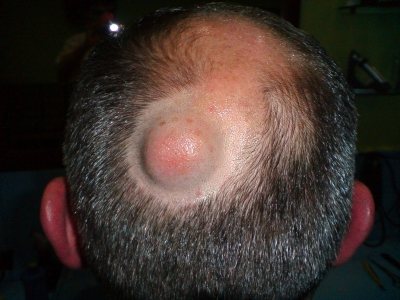
After the operation has been performed, do not forget about postoperative rehabilitation.
If the removal was performed traditionally or using a laser, antibacterial therapy is usually prescribed to avoid suppuration and inflammation of the scar.
The scar needs to be regularly disinfected and bandages changed (if any). You can wash your hair 1-2 days after removing the atheroma. After complete healing, regular hygiene of the scalp with gentle cleansers is important. For a while, you should refrain from dyeing and curling your hair, and you should also think about regulating the functioning of the sebaceous glands.
Atheroma in children
Young patients with this diagnosis are quite rare. The sweat and sebaceous glands in young children do not work well. Atheroma is a disease of adults.
The principles of treating benign tumors in young children are somewhat different. If older patients require immediate intervention, then in most cases children under three years of age do not undergo surgery.
Urgent surgery is required if:
- The cyst bothers the child.
- The surrounding tissues and vessels are compressed and swell.
- The cyst is growing quickly.
- Signs of inflammation appeared.
Why is surgery to remove atheroma in children undesirable? The main reason is the need for general anesthesia, which can harm a fragile body.
Local anesthesia will not be effective because the patient must be completely immobile. In the case of a small child, this condition is almost impossible to meet.
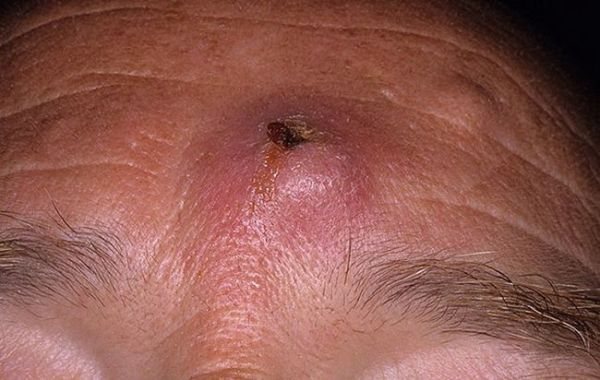
Before making a decision about surgery, you need to double-check the diagnosis. Sometimes atheroma is confused with other types of benign tumors that cannot be removed immediately. If you find a suspicious lump on your child’s head, immediately contact a dermatologist and surgeon.
Atheromas are also detected in newborns, the reason for which is the overly active functionality of the sebaceous glands and stagnation in the outflow of produced secretions. This is due to the fact that children have five times more sebaceous glands than adults. In very young children, atheromas can appear in the form of pinpoint rashes.
If the atheroma on the child’s head does not become inflamed, treatment is not necessary, since after a certain period of time it will disappear on its own. But if the inflammatory process develops, infection may occur. Then it is necessary to show the baby to a pediatrician, he will treat the affected area with an antiseptic and prescribe further therapy.
